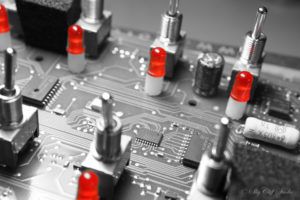
“There’s no rocket science to the puzzle. Dirty power degrades and destroys electronics.” – William Goldback, power-quality expert and IEEE life senior member
We talk so frequently about protecting “sensitive electronics.” So, I wanted to share just how tiny and delicate our electronic components are becoming – and give a thumbs-up to Gordon Moore.
In 1965, Intel co-founder Gordon Moore noticed that the number of transistors per square inch on integrated circuits had doubled every year since their invention. Moore’s Law predicted that this trend would continue.
It looks like he was right. Consider:
- Today’s smartphones have more computing power than all of NASA did when it started sending astronauts to the moon.
- At Apple’s iPhone 6 and 6 Plus event, the company’s Phil Schiller announced that the A8 chip inside the phones was made up of 2 billion transistors. That’s a lot of transistors – about twice as many found in Apple’s prior generation A7.
- Sometime in 2017, Intel will ship the first processors built using the company’s new, 10-nanometer chip manufacturing technology. Transistor gates – which turn transistors on and off – and the distance from one gate to another will be up to 46% smaller than today’s 14-nm technology.
So what does this all mean for us?
Smaller = More Sensitive = Harder to Protect
Transistors are the most sensitive critical component in today’s electronic chips. They act like tiny switches – and a voltage transient is their great nemesis.
Almost nine out of 10 harmful power line disturbances can be traced back to transient activity and inadequate surge protection.* Simply put, electrical transients are momentary increases in voltage created by switching loads. They’re a component of dirty power and come in two flavors:
- Impulse transients like lightning, electrical grid switching, motors, transformers, VFDs, welders, florescent lights, electrical power line failures and more.
- Low-level, high-frequency ring wave transients, which are ever-present.
Almost all ring wave transients are below the turn-on point of the avalanche diodes and MOVs used in panel-type surge suppressors on the market today. Most are less than 1000 volts. You need solid surge protection with tight filtering designed to handle these low-magnitude events. Otherwise? These transients will adversely impact performance and longevity.
Externally generated transients like lightning can be catastrophic. Luckily, they don’t happen often. But ring wave transients are happening all the time. As long as your equipment is operating, these internally generated, high-frequency transients are happening inside your facility. And they’re causing gradual degradation to all electronic components.
The Institute of Electrical and Electronics Engineers (IEEE) explains it like this:
- “A single lightning or switching surge often causes immediate, but not readily apparent physical damage to semiconductor devices. This damage then finally appears at some late time at which point the failure is obvious.”
- “This once controversial, but now accepted condition is called latent semiconductor device failure.”
Bottom line, what does this mean?
An enhanced transient filter is imperative. It will help you achieve sustainable performance and reliability of microprocessor-based or data-intensive applications in all facilities. Filtering helps reduce glitches, program lock-ups, and resets. It also protects that tiny integrated circuitry from damage.
Proper protection from damaging transients isn’t a product. It’s a well-thought-out system. These systems are a good investment and affordable, too.
Have questions or want to discuss more? Power quality systems are my passion. Give me a call at 479-244-0480.
* Source: IBM 24 Month Study of 200 Computer Sites

